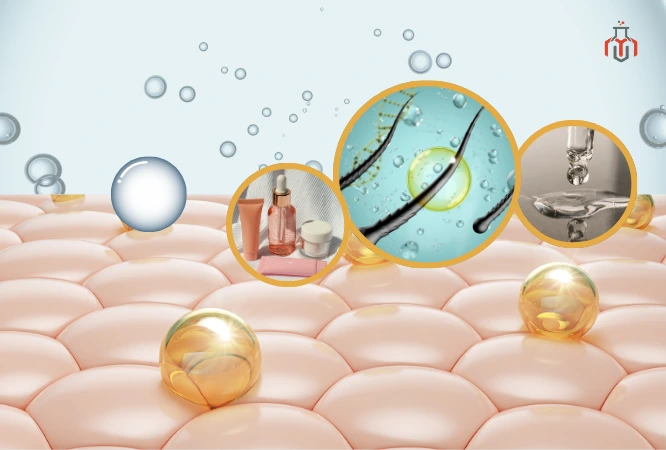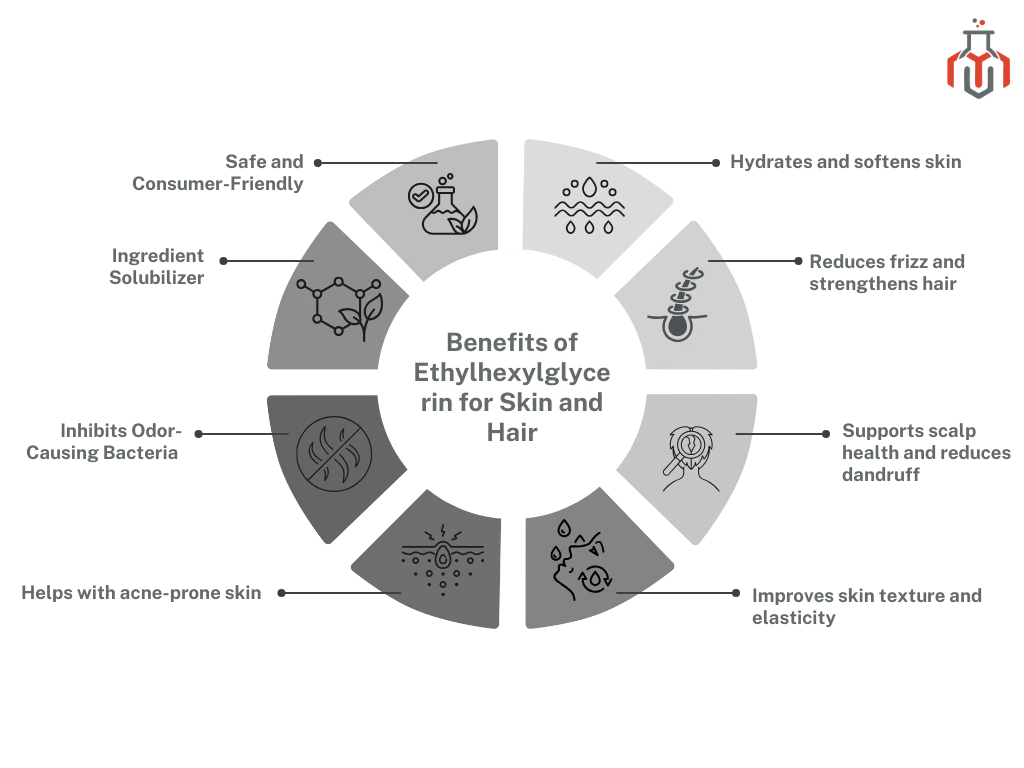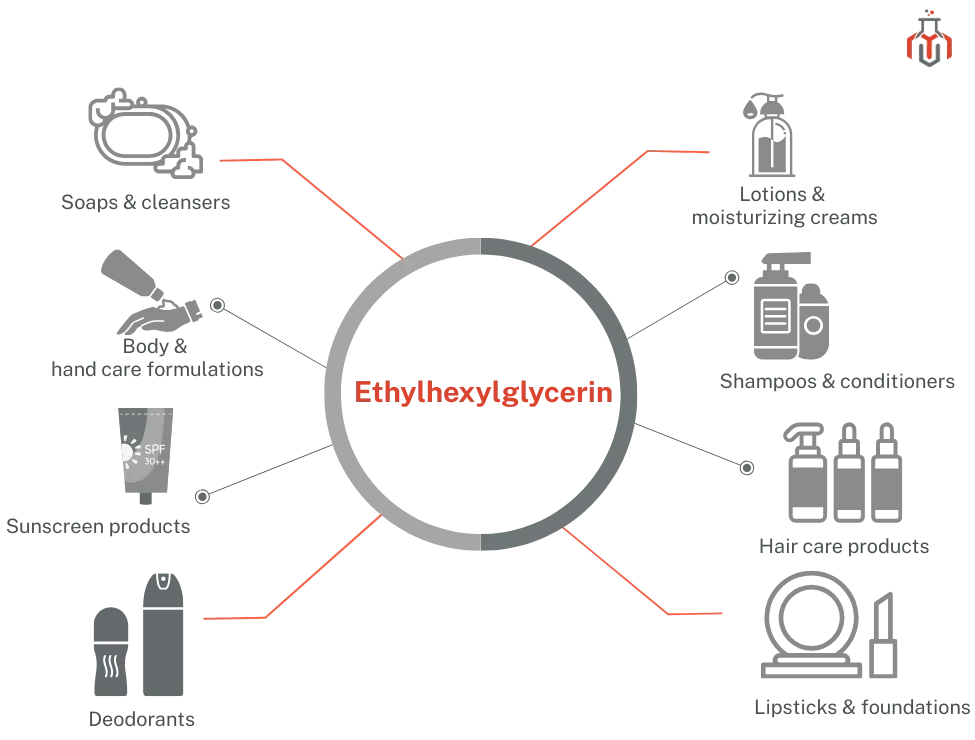
Ethylhexylglycerin is a synthetic compound derived from glycerin, a common ingredient in cleansers, deodorants, eye makeup, foundations, hair care, and suntan formulations. Chemically, it is synthesized through the etherification of glycerin with 2-ethylhexanol.
Ethylhexylglycerin has gained popularity in skin and hair care as it helps reduce the concentration of traditional preservatives such as parabens and phenoxyethanol in cosmetics. Apart from its preservative benefits, ethylhexylglycerin also has skin-soothing and humectant properties. It enhances antimicrobial efficacy and reduces the risk of contamination in cosmetic products.
Additionally, it acts as a surfactant, lowering the surface tension between ingredients and enabling oil and water to mix and remain stably blended within a formulation.
What is Ethylhexylglycerin and Where Does It Come From?
Looking beyond its multifunctional properties, ethylhexylglycerin is an alkyl glyceryl ether compound that has gained significant popularity in cosmetic formulations since its introduction in the 1990s.
Ethylhexylglycerin (C11H24O3) is primarily derived from glycerin, which can come from both plant-based and synthetic sources. Most commercial ethylhexylglycerin is produced through a chemical reaction between glycerin and 2-ethylhexanol, called etherification.
How Ethylhexylglycerin Works in Skin and Hair Care?
Ethylhexylglycerin is generally colorless and odorless in nature, and it can solidify at room temperature. It is soluble in fats but insoluble in water, making it ideal for oil-based formulations. Due to its compatibility with a variety of ingredients, it is widely used in emulsions, creams, serums, and lotions, as well as in surfactant-based products like shower gels, facial cleansers, and shampoos.
It enhances the epidermal softness and inhibits the growth of odor-causing microorganisms. It acts as an emollient and mild humectant, improving skin feel by keeping it gentle and smooth without leaving a sticky residue. It also improves the hair’s smoothness and flexibility and helps in solubilizing perfume oils and other ingredients, allowing them to remain longer on the skin.
Acts as a humectant and emollient
As a humectant, ethylhexylglycerin absorbs moisture from the atmosphere and binds it to the skin and hair, helping to maintain its hydration. It also possesses emollient properties, which make a protective, occlusive film on the surface. This film prevents transepidermal water loss (TEWL) and helps to maintain skin and hair soft, smooth, and conditioned.
Preservative and antimicrobial properties
Ethylhexylglycerin acts as a preservative booster by reducing the interfacial tension on the cell membranes of microorganisms. This action enhances the efficacy of other preservatives. Allowing formulators to use lower concentrations of other preservatives. It also has mild antimicrobial properties, which help to inhibit the growth of bacteria, yeasts, and molds.
Improves product texture and shelf life
It significantly extends the shelf life of products by protecting them against microbial contamination, ensuring the formulation remains safe and effective for a longer period.
According to the Cosmetic Ingredient Review (CIR) Expert Panel, ethylhexylglycerin is considered safe for use at concentrations of up to 8% in rinse-off products and up to 2% in leave-on formulations.
Benefits of Ethylhexylglycerin for Skin and Hair

Hydrates and softens skin
It functions as a humectant and helps in moisturizing and softening the skin surface by forming a thin, occlusive film on the epidermal surface, which helps reduce transepidermal water loss.
Reduces frizz and strengthens hair
Softens and conditions hair strands, improving overall texture and appearance. Prevents hair from becoming dry and brittle.
Supports scalp health and reduces dandruff
The antibacterial and antifungal properties of ethylhexylglycerin help prevent irritation and scalp disorders like dandruff. It soothes irritated, flaky scalps and creates a balanced condition for healthy hair growth.
Improves skin texture and elasticity
Enhances overall skin texture by maintaining moisture balance.
Helps with acne-prone skin
Ethylhexylglycerin is unlikely to clog pores. Its antimicrobial properties effectively target different bacterial strains, making it suitable for acne-prone skin.
Inhibits Odor-Causing Bacteria
During sweating, skin microbes break down sebum and dead cells into compounds that produce an unpleasant odor. The antimicrobial properties of ethylhexylglycerin inhibit the growth of these microorganisms, helping prevent body odor without affecting the normal skin.
Ingredient Solubilizer
Functions as a mild surfactant, helping to solubilize ingredients that don’t easily dissolve in water or oil, such as perfume oils.
Common Products Containing Ethylhexylglycerin
- Lotions and moisturizing creams
- Shampoos and conditioners
- Lipsticks and foundations
- Deodorants
- Sunscreen products
- Body and hand care formulations
- Soaps and cleansers

Who Should Avoid Ethylhexylglycerin?
- People with known sensitivities or allergies – Skin sensitivity varies person to person; it is advisable to take necessary precautions and patch test before using the products that contain ethylhexylglycerin.
- Pre-existing skin conditions – People already having skin problems like eczema or other forms of dermatitis are more susceptible to irritation or allergic reactions.
- Contact dermatitis – It has also been reported that ethylhexylglycerin causes skin irritation and dermatitis.
Safety of Ethylhexyglycerin
Ethylhexylglycerin is generally considered safe for use in cosmetics when used at appropriate concentrations. It has been reviewed and approved by cosmetic safety panels worldwide, including the Cosmetic Ingredient Review (CIR) and the European Scientific Committee on Consumer Safety (SCCS). Ethyhexyglycerin is safe at the concentration in existing products.
- leave-on cosmetics formulations such as sunscreens and serums – 0.002% to 2%
- Shampoo and other cosmetics – 0.000001% to 8%
Although it is safe for most people, there are still chances of allergies and skin irritation.
Faqs
Can ethylhexylglycerin cause skin irritation?
Ethylhexylglycerin is generally considered safe and well-tolerated for all skin types. However, some individuals may experience mild irritation or allergic reactions. It’s advisable to do a patch test before first use.
Is ethylhexylglycerin an animal by-product?
Ethylhexylglycerin is not an animal-derived compound. It is obtained from plant-based sources such as palm or soy and produced synthetically through a process called etherification.
Does ethylhexylglycerin cause hair loss?
There is no scientific evidence that ethylhexylglycerin causes hair loss. It is often combined with hair care products to promote healthy hair and scalp and prevent it from dryness.
Is Ethylhexylglycerin synthetic or natural?
Ethylhexylglycerin is a synthetic compound produced through a chemical process called etherification. Sometimes, confusion arises due to its precursor, glycerin, which is from plant-based sources such as palm or coconut oil.
Is ethylhexylglycerin a paraben?
Ethylhexylglycerin is not a paraben; it is a glycerin component that often comes from vegetable sources such as coconut, palm, or soybean oils and is often used as an alternative to parabens in cosmetic formulations.
Is ethylhexylglycerin the same as phenoxyethanol?
Ethylhexylglycerin is an alkyl glyceryl ether primarily used as a skin-conditioning agent and preservative enhancer, while Phenoxyethanol is an aromatic ether that helps to extend the shelf life of products by inhibiting the growth of microbes. Both ethylhexylglycerin and phenoxyethanol are often combined in formulations to improve product stability and preservation effectiveness.
Disclaimer:
The information provided in this blog is intended for general informational purposes only and is based on publicly available literature, cosmetic ingredient databases, and research publications. It should not be considered medical, dermatological, or regulatory advice. We disclaim any liability arising from the use of this information without appropriate professional consultation.
Resources
Cosmetic Ingredient Review Expert Panel, Safety Assessment of Ethylhexylglycerin (2011)
Ethylhexylglycerin-a Contact Allergen in Cosmetic Products
Ethylhexylglycerin: a low-risk, but highly relevant, sensitizer in ‘hypo-allergenic’ cosmetics

